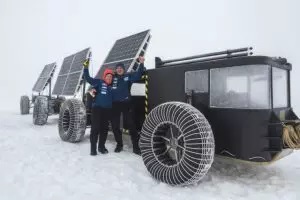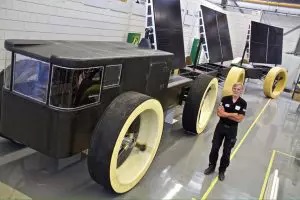Engineers from Holland intend to explore the South Belt using their own design. Lisbet and Edwin ter Velde skillfully combined research with alternative energy and got excellent results.
The Dutch created an electric all-terrain vehicle using a 3D printer. The material for the technical innovations were recycled waste. The all-terrain vehicle is equipped with solar modules that play the role of an energy block. The invention of the Dutch moves thanks to the electrical energy that is generate during the operation of the all-terrain vehicle panels installed on it.
The couple called their project Clean2Antarctica. This project was the result of a couple of years of experience in the development of an environmentally conscious lifestyle.
 Solar powered snowmobiles are now hard to surprise anyone. Yes and various items from recycled garbage in the civilized world is no longer a novelty. The peculiarity of the invention of the Dutch is that they created a transport from plastic waste, which is able to reach the South Pole without a drop of fuel.
Solar powered snowmobiles are now hard to surprise anyone. Yes and various items from recycled garbage in the civilized world is no longer a novelty. The peculiarity of the invention of the Dutch is that they created a transport from plastic waste, which is able to reach the South Pole without a drop of fuel.
The electric all-terrain vehicle was name the Solar Voyager. It was create from special blocks with six corners. HexCore were previously make using a 3D printer. The basis served as plastic.
Spouses claim that they have created the first few blocks from plastic waste that has accumulated in their homes. They independently crushed and melted plastic bottles. In this way, they created material that could use a 3D printer.
When the technology was already tested, industrial production of plastic granules came to the aid of the inventors. They were also make from recycled plastic. Pellets were supply from a waste processing plant in the suburbs.
The total amount of hexagonal blocks was 4 thousand. The Dutch chose blocks of exactly hexagonal shape, because this design is the most durable and has the least weight. By the same principle in the hive, bees create honeycombs for honey.
Hexagonal plastic blocks have become a building material for the body of an electric all-terrain vehicle. After assembly, the structure was supplement with four wheels. Then added a couple more trailers on two wheels. On the surface of the trailers and installed solar modules. In total, there are 10. Each panel is two-way, which significantly increases the volume of generation. In addition, in the trailers are food stocks, the number of which is calculate for 47 days of journey.
 However, travelers will not have a supply of drinking water. They intend to use the Arctic ice for this purpose. It will melt with the help of special tubes that placed on the panels.
However, travelers will not have a supply of drinking water. They intend to use the Arctic ice for this purpose. It will melt with the help of special tubes that placed on the panels.
Comfortable temperature inside the cabin will be create by infrared glass elements. They will catch the sun and create heat.
The whole construction together with trailers has a length of 16 meters. The electric all-terrain vehicle with related equipment in the kit weighs about 1.5 tons. A vehicle can reach speeds of up to eight kilometers per hour.
At the beginning of its implementation, the project suggested obtaining a new method for processing plastic waste. As a result, the goal was achieve with a pleasant bonus – the engineers received a high-tech device for research activities in harsh conditions.
The beginning of the mission is schedule for the end of November. Total mileage, which will pass electric all-terrain vehicle, is 2400 kilometers. The round trip should take a total of about 30 days.

